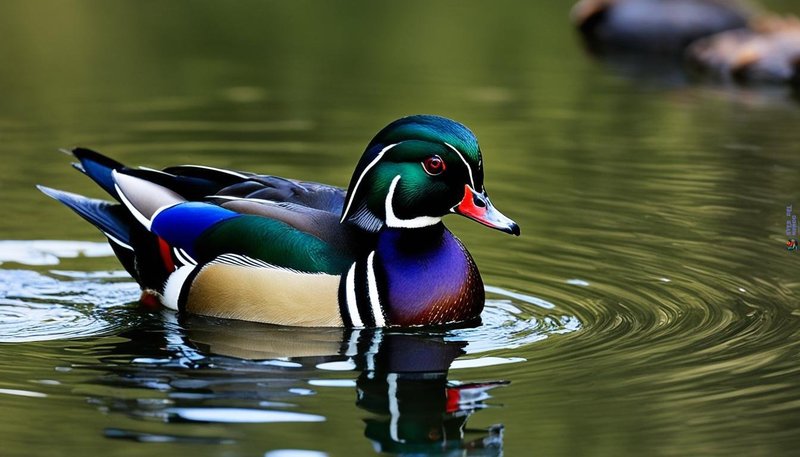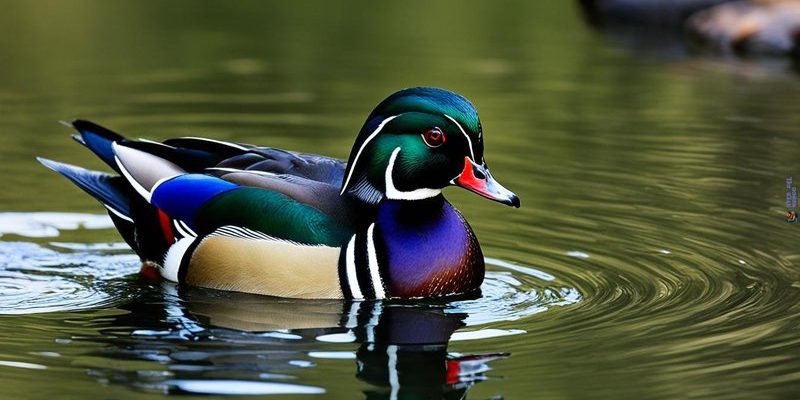
Identifying a wood duck doesn’t have to be difficult. Once you know what to look for, you’ll be able to pick out these magnificent birds from afar. Their striking appearance and unique behaviors make them a favorite among bird watchers. Here’s a friendly guide on how to identify a wood duck in the wild, so you can appreciate these stunning creatures even more.
Physical Characteristics of Wood Ducks
To start off, let’s dive into what makes wood ducks so visually stunning. The male wood duck is a sight to behold. He boasts a vibrant green head with purple and bronze highlights and a distinctive red eye. You might see a striking white throat patch that contrasts sharply with his deep, colorful body. If you’re lucky enough to catch a glimpse of him in flight, those long, pointed wings will really stand out, giving him an elegant silhouette against the sky.
The female wood duck, while less flamboyant, is equally beautiful in her own right. She has a more subdued gray-brown plumage, which helps her blend into her surroundings. Her head is adorned with a lovely white eye-ring and a light gray throat. At first glance, you might mistake her for a different species, but pay attention to her unique markings, and you’ll quickly realize she’s indeed a wood duck.
Behavioral Traits That Stand Out
Understanding the behavior of wood ducks is just as important as recognizing their appearance. These ducks are renowned for their arboreal habits, meaning they prefer wooded areas near water. You’ll often find them perched on tree branches, which is a telling sign that you’re in the right spot. They’re also quite shy and can be swift in flight, so patience is key when trying to catch a glimpse.
One fascinating behavior you might observe is their unique chick-rearing method. Female wood ducks are known to nest in tree cavities, far above ground. After the young hatch, they jump from the nest, often from heights of 10 to 20 feet! It’s a daring leap that showcases their adventurous spirit right from the start. Seeing this in action is quite a sight and a true testament to their resilience.
Preferred Habitats of Wood Ducks
If you want to increase your chances of spotting wood ducks, knowing where they hang out is essential. They thrive in wooded swamps, marshes, and ponds that have plenty of cover. Look for them near areas with still water and abundant vegetation. You might find them swimming gracefully among lily pads or lounging on logs.
Wood ducks are particularly fond of areas with a mix of water and trees. This means places like wetlands and rivers lined with overhanging branches are ideal. Keep an eye out for them at dawn or dusk, as they tend to be most active during these times. As a bonus, the soft light during these hours makes for stunning photographs if you want to capture their beauty.
Seasonal Changes and Migration Patterns
Understanding the seasons can also help you identify when to look for wood ducks. In the summer, males are in full breeding plumage, making them easier to spot. They typically breed from March to June, and that’s when you’re likely to see them more frequently. As fall approaches, however, they shed their colorful feathers for a more muted, camouflaged look, which makes them harder to spot.
During migration, wood ducks can travel considerable distances. They usually head south for the winter, seeking warmer waters. If you’re in the northern parts of North America, keep an eye out for them in the fall as they migrate, sometimes in small flocks, or even alone. Knowing the migration patterns can help you plan your birdwatching outings.
Listening for Their Distinct Calls
Another way to identify wood ducks is through their sounds. Each bird has its own unique call, and the wood duck is no exception. Males have a soft, whistling “peent” sound, while females are known for their more pronounced quacks. If you hear a series of high-pitched whistles while near a waterway, chances are you’ve stumbled upon a wood duck family.
Listening for their calls can be just as rewarding as watching them. Imagine sitting quietly by a pond as the sun rises, and suddenly, you hear that distinctive whistle. It can bring the whole experience of birdwatching to life, making it feel a bit magical.
Using Binoculars for Better Sightings
To really appreciate the beauty of a wood duck, consider investing in a good pair of binoculars. A decent pair can bring those vibrant colors up close and personal, enhancing your overall experience. Aim for binoculars with a magnification of at least 8x; this will give you a clearer view without compromising stability.
When selecting binoculars, look for features like waterproofing and fog proofing since you might be out in unpredictable weather. If you’re birdwatching near water, it’s wise to have equipment that can withstand a few splashes! Having the right tools can make identifying wood ducks much simpler and satisfying.
The Joy of Birdwatching
Finally, let’s not forget the simple joy that comes from birdwatching. It’s not just about identifying a wood duck; it’s about connecting with nature and finding peace in the moment. Every time you spot a wood duck, it’s a little victory that reminds you of the beauty surrounding us.
Take your time, be patient, and enjoy the process. Sometimes, it’s the quiet moments spent waiting for a wood duck to appear that become some of the most memorable. Whether you’re a seasoned birdwatcher or a curious beginner, there’s something special about experiencing wildlife in its natural habitat.
In conclusion, identifying a wood duck in the wild can be a delightful experience, filled with color, sound, and a bit of adventure. With the tips outlined in this guide, you’ll be well on your way to spotting and appreciating these magnificent birds. So grab your binoculars, find a cozy spot by the water, and immerse yourself in the serene world of wood ducks!

